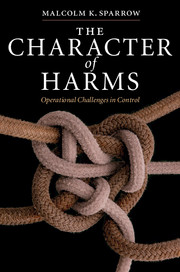Book contents
- Frontmatter
- Contents
- List of figures
- Acknowledgments
- Introduction
- Part I The nature of the control task
- 1 Which way up, and does it matter?
- 2 A different type of work
- 3 Defining problems: setting the scale
- 4 Defining problems: picking the dimensions
- 5 Patterns of thought and action
- 6 Puzzles of measurement
- 7 Structures, protocols, and interactions
- Part II Special categories of harms
- Conclusion
- Index
6 - Puzzles of measurement
from Part I - The nature of the control task
Published online by Cambridge University Press: 06 July 2010
- Frontmatter
- Contents
- List of figures
- Acknowledgments
- Introduction
- Part I The nature of the control task
- 1 Which way up, and does it matter?
- 2 A different type of work
- 3 Defining problems: setting the scale
- 4 Defining problems: picking the dimensions
- 5 Patterns of thought and action
- 6 Puzzles of measurement
- 7 Structures, protocols, and interactions
- Part II Special categories of harms
- Conclusion
- Index
Summary
Citizens should surely expect that government institutions whose core mission involves the reduction of harms should be able to give an account of their performance in terms of harms reduced, suppressed, mitigated or eliminated. All the more so if it is a regulatory agency, which imposes obligations, inconveniences, and costs on citizens and businesses. Those who are regulated have every right to know that regulatory impositions not only served worthwhile purposes, but were effective in achieving their aims. “If your business is harm-control, show me harms you have controlled.”
If the bulk of the work done, however, is organized around functions (such as enforcement), programs (e.g. partnership programs) or processes — rather than around identified concentrations of harm — then a compelling account of harms controlled will remain frustratingly elusive. Functional and programmatic work generates a natural and straightforward performance story about levels of activity, or outputs. The police made this many arrests and obtained that many convictions. OSHA visited this many worksites and generated so many millions of dollars in fines. Customs officials searched this many shipping containers, and seized that much contraband. In general, reporting officials like these numbers to be large, and preferably increasing year by year. These numbers demonstrate to taxpayers that their public officials are working hard and keeping busy. Dividing these numbers by the number of employees, or the financial resources expended, allows the public also to gauge productivity and efficiency.
- Type
- Chapter
- Information
- The Character of HarmsOperational Challenges in Control, pp. 123 - 148Publisher: Cambridge University PressPrint publication year: 2008



